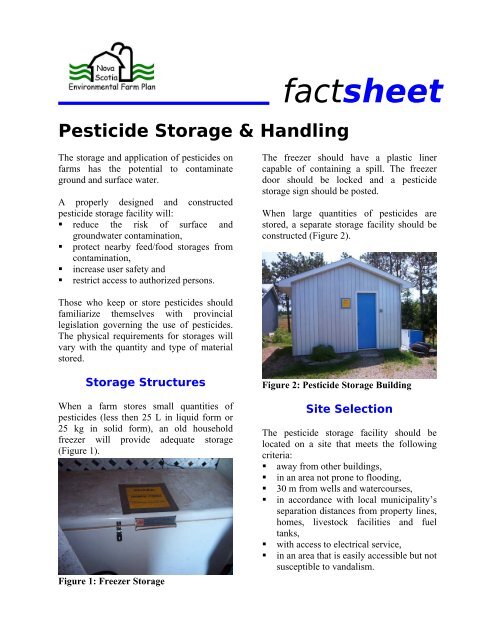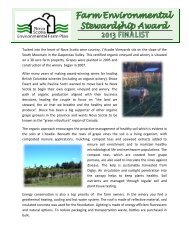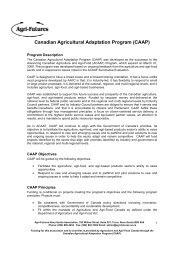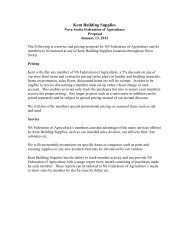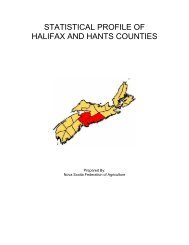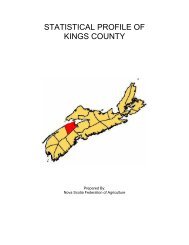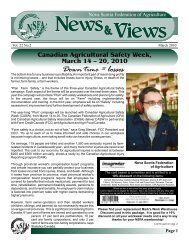Pesticide Storage and Handling - Perennia
Pesticide Storage and Handling - Perennia
Pesticide Storage and Handling - Perennia
Create successful ePaper yourself
Turn your PDF publications into a flip-book with our unique Google optimized e-Paper software.
<strong>Pesticide</strong> <strong>Storage</strong> & H<strong>and</strong>lingfactsheetThe storage <strong>and</strong> application of pesticides onfarms has the potential to contaminateground <strong>and</strong> surface water.A properly designed <strong>and</strong> constructedpesticide storage facility will:• reduce the risk of surface <strong>and</strong>groundwater contamination,• protect nearby feed/food storages fromcontamination,• increase user safety <strong>and</strong>• restrict access to authorized persons.The freezer should have a plastic linercapable of containing a spill. The freezerdoor should be locked <strong>and</strong> a pesticidestorage sign should be posted.When large quantities of pesticides arestored, a separate storage facility should beconstructed (Figure 2).Those who keep or store pesticides shouldfamiliarize themselves with provinciallegislation governing the use of pesticides.The physical requirements for storages willvary with the quantity <strong>and</strong> type of materialstored.<strong>Storage</strong> StructuresWhen a farm stores small quantities ofpesticides (less then 25 L in liquid form or25 kg in solid form), an old householdfreezer will provide adequate storage(Figure 1).Figure 1: Freezer <strong>Storage</strong>Figure 2: <strong>Pesticide</strong> <strong>Storage</strong> BuildingSite SelectionThe pesticide storage facility should belocated on a site that meets the followingcriteria:• away from other buildings,• in an area not prone to flooding,• 30 m from wells <strong>and</strong> watercourses,• in accordance with local municipality’sseparation distances from property lines,homes, livestock facilities <strong>and</strong> fueltanks,• with access to electrical service,• in an area that is easily accessible but notsusceptible to v<strong>and</strong>alism.
<strong>Storage</strong> Organization• <strong>Pesticide</strong>s should be stored off the flooron sturdy, steel shelves (Figure 4).Shelves should be made of a noncombustiblematerial that can be easilycleaned. All shelving should be attachedto the wall for stability.• Products should be organized in groups(i.e. herbicide, fungicide, insecticide).Safety <strong>and</strong> ProtectiveEquipment• First aid kit• Eye wash station• Fire extinguisher• Containment <strong>and</strong>/or clean-up materials(i.e. peat moss, cat litter, absorbentmaterials, etc.) should be available at alltimes to minimize the risk of watercontamination during a spill orunintentional release of pesticidesSignageFigure 4: Shelving <strong>and</strong> Organization• Metal containers should be h<strong>and</strong>led in away that will prevent corrosion <strong>and</strong>leakage.• Opened containers should be re-sealed<strong>and</strong> stored upright.• Opened bags of dry pesticides should bestored inside a second clear bag to avoidmoisture damage <strong>and</strong> spillage. Ensurethe pesticide label is still visible.• Rodent baits should be stored away fromother pesticides.• Purchase pesticides by season <strong>and</strong> storeas little as possible.• Mark the product purchase date on allcontainers to ensure the oldest containersare used first.• Read <strong>and</strong> follow all label directionsregarding storage conditions.• Signs stating “WARNING CHEMICALSTORAGE – AUTHORIZRD PERSONNELONLY” <strong>and</strong> “NO SMOKING” should beposted at the point of entry.• Emergency numbers should be postednear the door of the building <strong>and</strong> thenearest telephone. The local fire brigadeshould also be made aware of thelocation, type <strong>and</strong> general quantity ofpesticides stored on the farm.MixingWater used for filling the pesticide sprayershould be supplied from a bulk water tank.If the sprayer is filled from a tap, ensure thetap is fitted with an anti-backflow device.Greenhouse operations with pesticidemixing units should have a check valveinstalled on the waterline.It is important to ensure that someone isconstantly watching the sprayer duringfilling to prevent overflows, as sometimesthe sprayer is not completely empty whenrefilling or pesticides are added duringfilling. <strong>Pesticide</strong>s should be added to thesprayer at a location that is at least 30 metersfrom the nearest well, watercourse or pond.
H<strong>and</strong>lingDifferent precautions are required whenh<strong>and</strong>ling various pesticides because theydiffer in toxicity. Hazard ratings inform theuser as to how each product should beh<strong>and</strong>led.Hazard Ratings:Requires goggles,respirator, gloves <strong>and</strong>skin protection. Avoidfumes <strong>and</strong> spray mist.Requires goggles,gloves <strong>and</strong> skinprotection. Avoidfumes <strong>and</strong> spray mist.Requires gloves <strong>and</strong>skin protection. Avoidfumes <strong>and</strong> spray mist.If a hazard symbol does not exist on theproduct, it is likely of low toxicity tomammals. However, protective clothingshould always be used, even if there is nohazard symbol.If symptoms of illness occur during orshortly after pesticide use, the individualshould immediately get to a hospital orphysician. The container or product label ofthe pesticide that was in use should bebrought with them.Disposal of <strong>Pesticide</strong>ContainersEmpty pesticide containers are not reallyempty. As much as two to four ounces of thechemical can remain inside an empty, unrinsedcontainer. Rinse the containersimmediately after they are emptied. Emptythe container into a spray tank <strong>and</strong> let itdrain for 30 seconds. Fill the container atleast one-fifth full with clean water. Shakeor swirl vigorously to rinse all insidesurfaces. Empty the rinsate into the spraytank <strong>and</strong> let the container drain for 30seconds. Repeat the procedure two moretimes, then puncture the container.Plastic containers must be disposed of at acollection facility <strong>and</strong> unused product mustbe disposed of in a manner specified on thelabel. Empty pesticide bags can be placed inthe garbage.Disposal of <strong>Pesticide</strong>Sprayer RinsateRinsate can be sprayed over the field againonce the rinsing is complete. When a fieldhas already been sprayed at the full rateavoid covering the same ground againbecause of the risk of crop damage. Insteadthe rinsate can be sprayed along fieldborders, as long as they are not adjacent tosensitive areas.SummaryA properly constructed pesticide storagefacility will reduce the risk of surface <strong>and</strong>groundwater contamination, increase usersafety, protect nearby feed/food storagesfrom contamination <strong>and</strong> limit access toauthorized persons only.Prepared in 2006 using: ACAE On-Farm <strong>Pesticide</strong><strong>Storage</strong> publication, Agdex No: 607/790


